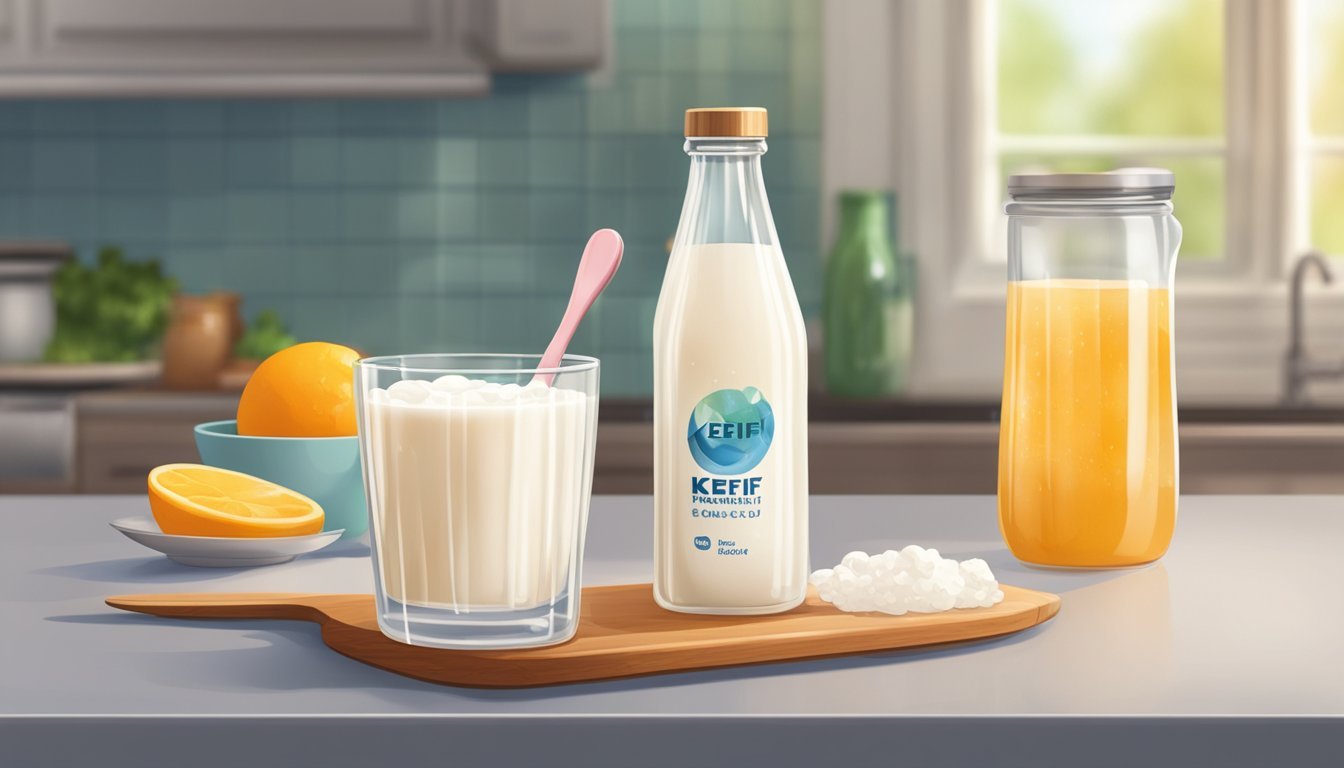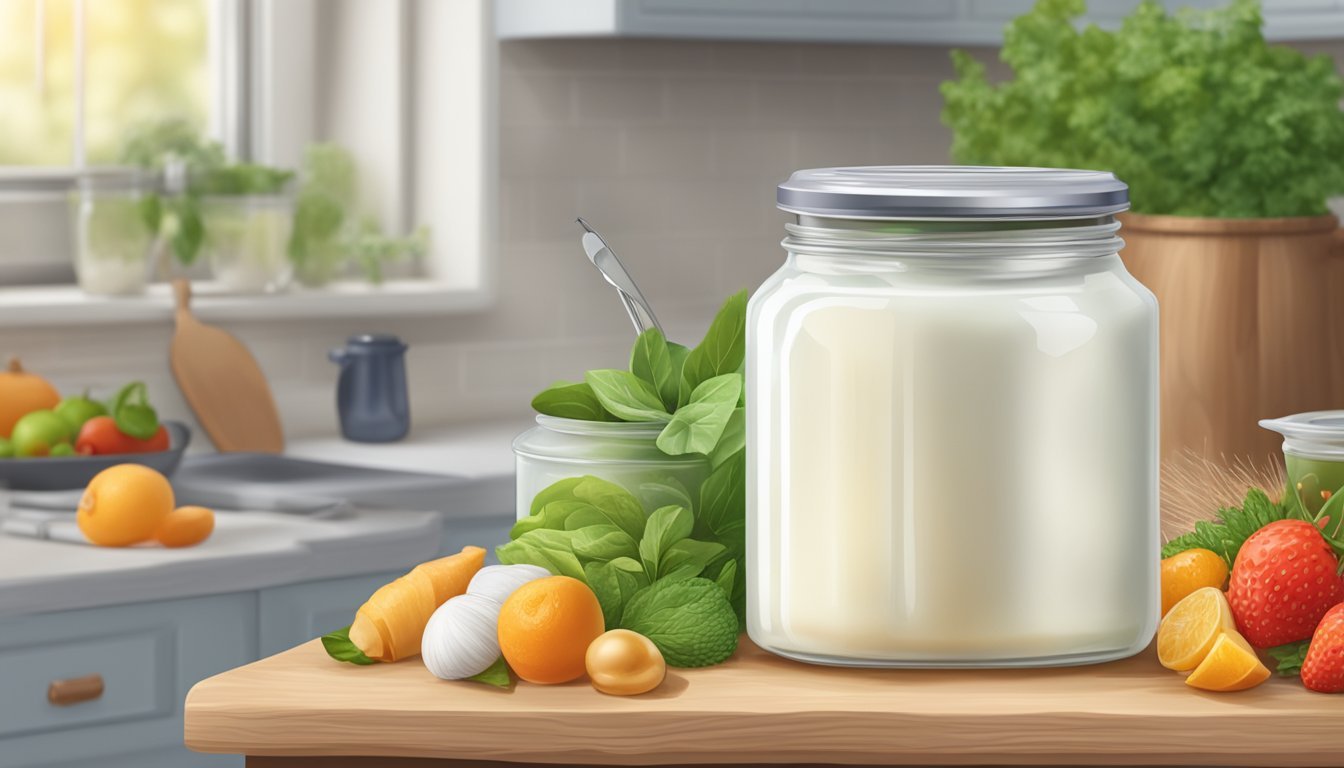Does Kefir Spoil?
Understanding Its Shelf Life and Storage
Kefir is a fermented dairy product known for its probiotic properties and health benefits. It is widely appreciated for its tangy flavor and nutritional value, but many people wonder if kefir can spoil. Yes, kefir does spoil, despite its fermented nature. When properly stored in the refrigerator, kefir typically lasts up to two weeks after opening, though its taste and quality might start to decline after about a week.
Although kefir is more resistant to spoilage than fresh milk, it is essential to pay attention to the expiration date and proper storage methods. Signs of spoiled kefir include a sour smell that is different from its usual tanginess, curdling, and a change in color. Consuming spoiled kefir can lead to discomfort or health issues, making it crucial to check for these spoilage indicators regularly.
Understanding the shelf life of kefir and monitoring its condition ensures you can enjoy its probiotic benefits without any adverse effects. Store it in the coldest part of your refrigerator, tightly sealed, to maximize its longevity. This careful attention to storage will help preserve its health benefits and delightful taste.
Understanding Kefir
Kefir, a fermented milk drink, has origins in the Caucasus Mountains. It's created through a fermentation process that involves a symbiotic culture of bacteria and yeast, often referred to as kefir grains.
These grains ferment the milk, producing a slightly tangy and effervescent beverage. During fermentation, bacteria convert lactose into lactic acid, giving kefir its distinctive taste.
Bacteria and Yeast:
The bacteria and yeast in kefir grains produce a variety of probiotics. These beneficial microorganisms can support digestive health.
Probiotics:
Kefir contains several strains of probiotics, including Lactobacillus kefiri, which may help balance gut flora.
Nutrients in Kefir
Kefir is rich in several nutrients. Below is a brief overview:
Vitamins: Contains B vitamins, particularly B12, which is vital for energy production.
Minerals: A good source of calcium and phosphorus, essential for bone health.
Proteins: Supplies complete proteins that aid in muscle repair and growth.
Nutrient Benefit Calcium Bone health Phosphorus Energy production B vitamins Energy and metabolism Probiotics Gut health and immunity
This fermented dairy product also offers a unique texture, slightly thicker than milk but thinner than yogurt. This makes it versatile for various culinary uses, from smoothies to salad dressings.
Fermentation Time:
Kefir typically ferments over 24 hours. The longer the fermentation, the tangier and thicker it becomes. Proper storage in an airtight container in the refrigerator can extend its shelf life.
Signs of Spoiled Kefir
Identifying spoiled kefir is crucial for maintaining food safety and ensuring the best taste experience. Key indicators include altered texture, unexpected flavor changes, presence of mold, a sour smell beyond normal fermentation, and discoloration.
Altered Texture
Spoiled kefir often exhibits a noticeable change in texture. Instead of being smooth and creamy, it may become excessively thick or develop lumps. Grittiness or a separated, watery consistency can also indicate spoilage. These changes happen when the balance of beneficial bacteria and yeast is disrupted, leading to improper fermentation.
Unexpected Flavor Changes
Kefir generally has a slightly tangy, refreshing taste. When spoilage occurs, the flavor can shift significantly. Overly sour or bitter notes are common signs of spoiled kefir. The taste may become unpleasant, losing its usual mild tanginess. If the flavor profile changes drastically, it's a strong indicator that the kefir is no longer safe to consume.
Presence of Mold
The presence of visible mold is a clear and immediate sign that kefir has gone bad. Mold spots can appear in various colors, often green, blue, or black, and should never be ignored. Consuming moldy kefir can pose health risks, as molds can produce harmful toxins. Once mold is detected, it's essential to discard the entire batch.
Sour Smell Beyond Normal Fermentation
Kefir has a natural sour smell due to the fermentation process. However, if this sourness intensifies and becomes unpleasant or overpowering, it indicates spoilage. A foul odor that is sharply offensive rather than just tangy suggests the kefir should not be consumed. This change in smell results from the overgrowth of undesirable bacteria.
Discoloration
Healthy kefir typically has a consistent color, usually white or slightly off-white. Spoiled kefir may display discoloration, such as yellowing or the appearance of unusual streaks. This sign, combined with other indicators like texture change or off-smell, confirms that the kefir has deteriorated. Always trust your senses in assessing any unusual visual changes.
Shelf Life and Storage
Kefir's shelf life depends greatly on storage practices and temperature management. Proper handling can extend its freshness and ensure it remains safe for consumption.
Proper Storage Practices
To maintain kefir's freshness, it's essential to store it correctly. Sealed, airtight containers are ideal for storing kefir as they minimize exposure to air and contaminants. Glass jars or plastic containers with tight-fitting lids work well.
Always keep kefir in a sterilized container to prevent bacterial growth. Moreover, ziplock bags can be used for smaller servings. Proper storage not only extends the shelf life but also preserves the probiotic benefits of kefir.
Impact of Temperature on Shelf Life
Temperature plays a critical role in the shelf life of kefir. The ideal storage temperature for kefir is between 40°F and 50°F (4°C and 10°C). Temperatures above this range can accelerate spoilage and degrade the product's quality.
Avoid leaving kefir at room temperature for extended periods, as this can lead to rapid microbial growth. Proper temperature management is essential to keep kefir safe and fresh for longer periods.
Using the Refrigerator
Refrigeration is a highly effective method for extending kefir's shelf life. When stored in the refrigerator, unopened store-bought kefir can last 1-2 weeks past its printed date.
Homemade kefir, on the other hand, can stay fresh for up to 2-4 weeks. Ensure that the refrigerator is set to the appropriate temperature range to maintain the best quality. Keep the kefir containers towards the back of the fridge where the temperature is more stable.
Freezing Kefir
For longer-term storage, freezing kefir is a viable option. Kefir can be stored in the freezer for up to three months without significant loss of quality.
When freezing, use airtight containers or ziplock bags to prevent freezer burn. Leave some space in the container for expansion, as kefir expands when frozen. Label the containers with the freezing date to track storage time.
Thaw frozen kefir in the refrigerator rather than at room temperature to maintain its texture and flavor. Freezing can slightly alter the texture, but the probiotic properties remain intact.
Consuming Kefir Safely
Consuming kefir safely involves ensuring its freshness, adhering to guidelines for opened kefir, and carefully assessing homemade kefir. Each step is crucial in preventing spoilage and ensuring that the kefir remains healthy for consumption.
Evaluating Freshness
To consume kefir safely, check its freshness. Unopened kefir typically remains good for a few days past its printed expiration date if stored properly in the refrigerator.
Inspect the smell, taste, and appearance. Fresh kefir has a slightly tangy aroma and a consistent texture. Sour odors, off-tastes, or curdled texture indicate that the kefir has gone bad and should not be consumed.
Monitoring the expiration date and proper storage minimizes the risk of consuming expired kefir.
Guidelines for Consumption after Opening
After opening, kefir should be consumed within a specific timeframe for safety. Opened kefir remains fresh for about 7 to 14 days if kept refrigerated.
Use an airtight container to maintain its quality. When in doubt, apply the same sensory checks as with evaluating unopened kefir – smell, taste, and look.
Always write the date of opening on the container to track its freshness easily.
Assessing Homemade Kefir
When making homemade kefir, ensuring safety is paramount. Fermentation must be done correctly, maintaining clean equipment and proper temperatures.
Homemade kefir generally lasts 7 to 10 days when refrigerated. If it develops an unusual smell, taste, or appearance, it should not be consumed.
Additionally, monitor the health of the kefir grains used since their condition directly impacts the quality of the homemade kefir.
Kefir Versus Other Fermented Dairy Products
Kefir is often compared to other fermented dairy products, particularly yogurt and traditional milk. Each product has unique characteristics in terms of preparation, health benefits, and spoilage tendencies.
Comparison with Yogurt
Kefir and yogurt both originate from the fermentation of milk by beneficial bacteria, but they differ in several key aspects.
Starter Cultures: Kefir is made using a combination of bacteria and yeast cultures, while yogurt typically uses only bacteria. This difference influences the texture and flavor of each product.
Texture and Consistency: Kefir tends to be more liquid due to the specific strains of bacteria and yeast that produce carbon dioxide, resulting in a bubbly, drinkable texture. In contrast, yogurt is thicker and creamier.
Probiotic Content: Kefir contains a wider variety of microorganisms, often up to 30 or more different strains. Yogurt usually contains fewer strains, which might limit its probiotic diversity.
Fermentation Time: Yogurt is typically ready within a few hours, whereas kefir fermentation takes about 24 hours, allowing for more complete fermentation of the lactose in the milk.
Health Benefits: Both provide probiotics, aiding in digestion and gut health, but kefir's broader microbial diversity may offer additional benefits.
Differences from Traditional Milk
Fermentation Process: Unlike traditional milk, kefir undergoes fermentation, transforming it from sweet to tart. This process also breaks down lactose, making kefir more suitable for lactose-intolerant individuals.
Microbial Content: Traditional milk contains few if any live cultures, especially when pasteurized. Kefir, whether made from pasteurized or unpasteurized milk, teems with beneficial microorganisms.
Nutritional Profile: Kefir generally has a higher probiotic content compared to traditional milk. While both are good sources of calcium and protein, the fermentation process in kefir enhances its nutritional profile by adding bioactive compounds.
Shelf Life and Spoilage: Traditional milk spoils primarily due to the growth of unwanted bacteria. Spoiled milk emits a sour smell and curdles. On the other hand, kefir has a longer shelf life due to its beneficial microbial content, although it too can spoil if not stored properly, particularly if exposed to warm temperatures.
These points highlight the distinct differences and unique attributes of kefir when compared to yogurt and traditional milk.
Possible Complications and Tips
Kefir, like any fermented dairy product, requires care in handling to maintain quality. Addressing contamination, over-fermentation, separation, and effervescence can ensure the product remains safe and tasty.
Preventing Contamination
Ensuring kefir remains uncontaminated involves diligent hygiene. Microbial contamination is a significant risk, necessitating clean utensils and containers. Use sterile or freshly washed equipment when handling kefir grains.
Storing kefir away from direct sunlight is crucial, as UV exposure can promote the growth of unwanted bacteria. Regularly cleaning storage containers and replacing them if they show signs of wear can also prevent contamination. Always close the lid tightly, but allow some airflow to avoid creating a vacuum.
Avoiding Over-Fermentation
Over-fermentation can result in an overly sour kefir, reducing its palatability. It is essential to monitor the fermentation process closely. Typically, fermenting kefir for 24-48 hours at room temperature is optimal.
Labeling jars with the start date can help track time accurately. If a more mild flavor is preferred, refrigerate the kefir after 24 hours. If fermenting in a warmer environment, check the kefir more frequently to prevent it from fermenting too quickly.
Managing Separation
Separation into curds and whey is common and can make kefir appear spoiled. This phenomenon occurs naturally during the fermentation process.
To manage this, stir the kefir regularly or shake the container gently before use. If separation persists, strain the kefir through a fine mesh or cheesecloth to achieve a smoother consistency. Proper storage at a consistent temperature can also minimize separation.
Responding to Fizz and Gas
Fermentation can produce fizz and gas, often observed when opening the container. This is usually harmless but can be problematic if it leads to excessive bloating or discomfort.
If the kefir becomes too fizzy, opening the container slowly can help release the gas gradually. Stirring the kefir can also reduce the fizziness. Keeping kefir tightly but not completely sealed prevents excess gas buildup, while regular burping of the container ensures a controlled environment.
Health and Nutritional Benefits
Kefir, a fermented milk drink, offers numerous health benefits, particularly related to digestion, immune support, and nutrient absorption.
Digestive Health and Probiotics
Kefir contains a rich array of probiotics, beneficial bacteria that support gut health. The Lactobacillus kefiri strain found in kefir helps maintain a healthy balance of gut flora, which is essential for proper digestion.
These probiotics can aid in the breakdown of lactose, making kefir easier to digest for those who are lactose intolerant. Regular consumption of kefir can alleviate symptoms such as bloating and constipation by promoting regular bowel movements.
Immune System Support
Probiotics in kefir also play a role in enhancing the immune system. By maintaining a balanced gut microbiome, they help prevent the growth of harmful pathogens.
Kefir stimulates the production of immunoglobulins and other antibodies, bolstering the body's natural defenses. Additionally, kefir contains essential vitamins, such as vitamin D, which are vital for immune function. Regular intake can thus reduce the risk of infections and improve overall health.
Nutrient Absorption
Kefir improves nutrient absorption by maintaining a healthy gut lining. This not only ensures better digestion but also enhances the uptake of nutrients such as calcium, magnesium, and phosphorus.
These minerals are crucial for maintaining strong bones and overall body function. The drink's bioavailability of these nutrients makes it a superior choice for those looking to maximize their dietary intake of essential vitamins and minerals.
Creative Uses for Kefir in Cooking
Kefir, a versatile and fermented milk product, enriches various recipes with its unique tangy flavor and probiotic benefits.
Kefir can substitute for buttermilk or yogurt in baking. Use it in muffins, pancakes, or scones for a distinct, moist, and tender texture.
For savory dishes, blend kefir into soups like cream of mushroom, tomato soup, or borscht to introduce a creamy consistency without excess calories. Stir it in during the final minutes of cooking to preserve its probiotics.
Incorporate kefir into salad dressings for a twist on traditional vinaigrettes. Mix it with herbs, garlic, and lemon juice for a refreshing, flavorful dressing.
Kefir works well as a base for dips and spreads. Combine it with mashed avocados, garlic, and cilantro for a creamy, nutritious guacamole.
Use kefir to marinate meats. Its acids and enzymes tenderize tougher cuts while adding a delightful tanginess. Perfect for grilling, roasting, or sautéing.
Even desserts benefit from kefir’s versatility. Try a strawberry kefir smoothie or use it in cakes and frostings for a moist and zingy treat.
In summary, kefir's adaptability makes it an excellent addition to both sweet and savory recipes, enhancing flavors and textures.
Identifying Quality Kefir
High-quality kefir can be identified by examining expiration dates, the integrity of packaging, and the condition of kefir grains. Each of these aspects ensures that the kefir is fresh, potent, and safe for consumption.
Reading Labels and Expiration Dates
Labels provide crucial information. Expiration dates are essential indicators of freshness. Kefir should retain its quality for several days past the printed date.
When purchasing, ensure the date is well ahead. Pay attention to any additional notes about how long it lasts after opening, typically up to two weeks.
Understanding the Importance of Packaging
Packaging plays a vital role in maintaining kefir quality. Fermented milk products should be stored in airtight containers to prevent contamination.
Glass packaging is preferred as it is less likely to leach chemicals compared to plastic. However, high-quality plastic can also be effective if it is food-safe and free of BPA. Always check for a secure seal.
Assessing Kefir Grains Quality
Kefir grains are the live cultures that ferment the milk. The color and size of kefir grains can indicate their health.
Healthy grains are typically off-white and gelatinous. They should be plump and slightly translucent. If they appear brown or significantly smaller, it could indicate they are not in optimal condition. High-quality grains ensure the kefir's potency and nutritional value.
Handling and Serving Suggest
When handling kefir, always use clean utensils to avoid introducing bacteria that can spoil the product. Do not drink directly from the kefir container to maintain its quality and avoid contamination.
Once kefir is opened, store it in the refrigerator. This helps preserve its flavor and texture and extends its shelf life. Opened kefir typically lasts up to two weeks if properly stored.
When serving kefir, it can be enjoyed on its own or as a versatile ingredient in various dishes. Pour kefir into a glass and consume it chilled for a refreshing drink. Use it as a base for smoothies or mix it with fruit and honey for added sweetness.
Kefir also works well in savory dishes. Replace buttermilk or yogurt in recipes with kefir to add a tangy flavor. It can be used in salad dressings, marinades, or even as a topping for soups and stewed dishes.
For storage, keep kefir in its original container with the lid tightly closed. To avoid spoilage, ensure it remains in the coldest part of the refrigerator and away from the door.
By following these handling and serving suggestions, one can maintain the quality of kefir while enjoying its various uses in the kitchen. Proper storage and careful handling help ensure kefir remains fresh and beneficial for consumption.










